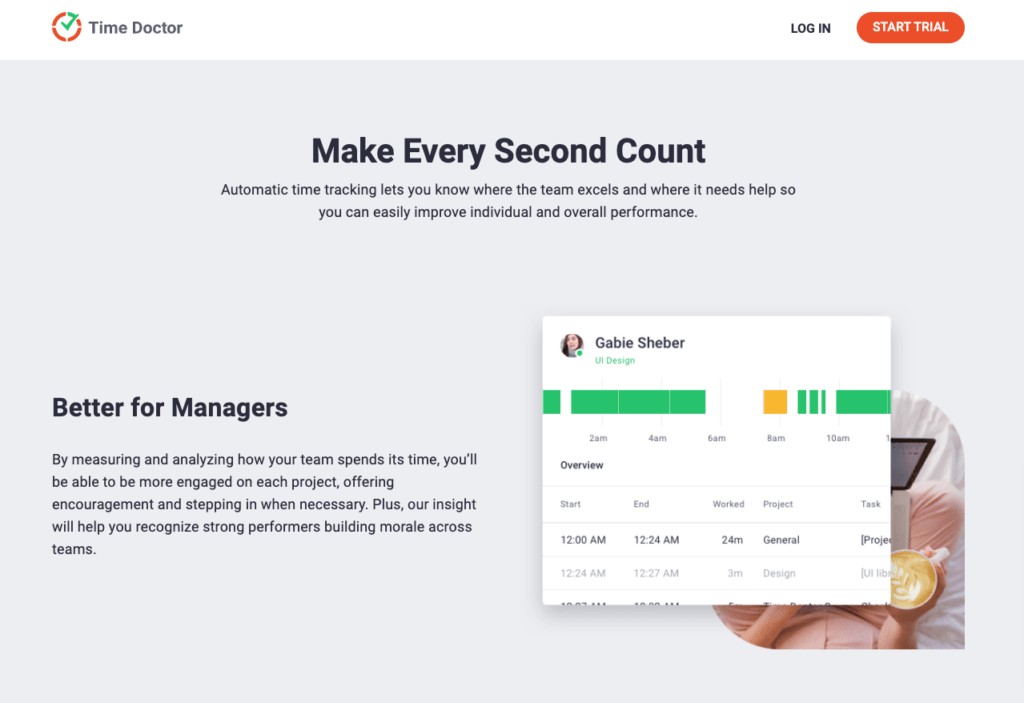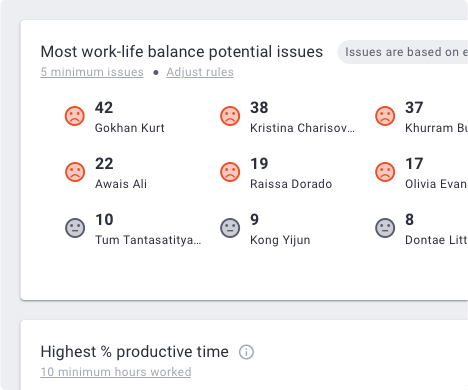Work fatigue is something that we all experience. If you spend a good deal of time at work, then you might be familiar with this problem. You feel tired, your eyes are getting red, and you just can’t take it anymore.
Work fatigue is a physical, mental, and emotional condition that affects the way we work. It’s almost like a form of stress that happens when you do a single task for too long. We’ve all been there before — feeling the effects of work fatigue. Sometimes it can even lead to burnout, but well, that’s an extreme condition of work fatigue. And “burnout” usually happens when work fatigue usually goes on without being checked.
The good news is that work fatigue is not an incurable disease.
Symptoms and effects of disease must be understood before it can be cured. The same goes for feeling burnout. If the symptoms are caught early on, then they can be dealt with easily. The employees can go back to their optimum performance while keeping their minds and bodies checked.
Table of Contents
- What does work fatigue mean?
- What are the symptoms of work fatigue?
- What causes work fatigue?
- How to measure work fatigue?
- How does work fatigue affect the workplace?
- How managers can spot early signs of employee work fatigue?
- 7 ways to overcome work fatigue
What does work fatigue mean?
We have all felt it, either at the start of the day itself or probably by mid-afternoon.
We all feel tired, lethargic, and unwell even when we’re not sick or physically exhausted. It becomes a problem when this feeling starts persisting every minute and every day. You end up losing your zeal to perform and work.
Also, this leads to an employee no longer having any confidence and eventually even leaving their job.
As per the Mayo Clinic, work fatigue is defined as:
“Unrelenting exhaustion that isn’t relieved by rest, a nearly constant state of weariness that develops over time, reducing your energy, motivation, and concentration.”
And burnout though not a medical condition, still is a serious condition.
Constant work stress can lead to both physical and mental exhaustion. It ultimately leads to reduced work and personal accomplishment and a person feeling the loss of their identity. But it does not just work stress that leads to work fatigue and then eventually burnout. And it can also stem from unchecked depression, anxiety, and other mental illnesses.
And that is why it becomes more and more crucial to understand the symptoms and the cause of work fatigue. Let’s first look at the symptoms of work fatigue and then what causes work fatigue.
What are the symptoms of work fatigue?
Are you wondering if you are suffering from work fatigue?
Here are a few symptoms that you can cross-check to see if you are actually suffering from work fatigue or if anyone in your office is suffering from it, so you can take the necessary steps to help them.
1. Chronic tiredness and sleepiness
When employees display behavioral signs of fatigue, such as drooping heads, constant yawning, and eyelids that become very heavy, it’s generally a good idea to let them take a break and even ask if they are doing fine. But these aren’t the only indicators that someone is tired.
Other signs include an inability to concentrate, slower reaction times, and making more errors due to reduced psychological performance; we will cover them one by one.
2. Quick to anger and irritability
After workers have been hard at work for a long period of time, they can become irritable.
One way to tell if someone is suffering from occupational irritability is paying attention to the type of attitude they present towards their coworkers – an especially good sign will be when these symptoms occur, along with some of the other common points on this list: sleeplessness or weight loss!
3. Absentmindedness and memory issues
Don’t ignore it when employees and workers look like they’re having trouble focusing or are forgetting some of the most basic things. This is a common occurrence in fatigued people.
Check for workers who act absent-minded most of the time and if they are able to focus, have difficulty recalling simple things like the things that just took place or what was just said. It’s also good to watch for workers who might have trouble solving problems and those who appear preoccupied with trying to figure out simple issues that could easily be answered by a manager in charge rather than them going it alone.
4. Lack of motivation to do anything
Employees who suddenly lack the motivation to do their job, even though they show up on time and are generally well-behaved, could be experiencing signs of workplace fatigue.
For example, according to research published by the Occupational Safety & Health Administration (OSHA), substance abuse and addiction are one of the most common causes or signs of workplace fatigue, among other causes. Some employers aren’t able to recognize the warning signs because they are so used to seeing them in their workers.
5. Increase in work mistakes
If your employee has been making numerous errors at work or is choosing not to complete their share of the workload, there may be a good reason why. As insomnia and excessive stress are possible side effects of sleep deprivation, it might help for you to make sure you are getting your eight hours no matter how difficult that may be or if you are overworked.
If so, those mistakes could potentially be related to fatigue and the need for a good night’s sleep and a little time off!
6. Increased headache
Headaches are a sign of overexertion, and even headaches could be a symptom. If these occur, you need to make sure employees are hydrated.
One big mistake employers make underestimating the number of fluids their workers need and providing overwork to their employees while setting unreachable targets.
Make sure the temperature won’t reduce dexterity, cause dehydration or adversely affect performance before you let your staff work under potentially dangerous conditions!
7. More susceptible to sickness
You all and I already know how exhausting it can be to work every day without much of a break. Eventually, if you don’t get the right amount of sleep, you become tired and less capable of fighting off sickness.
For example: if your body isn’t strong enough to handle a certain disease, it’s not uncommon to see an increase in sick days and absences.
Now that we know the symptoms of work fatigue, let’s look into the causes of work fatigue.
What causes work fatigue?
You might think that remote work might have reduced work fatigue, but it has intensified the situation for the worst. With work hours diminishing, employees are spending day and night finishing the work. Sometimes work even extends during the weekends, which leads to very little relaxation time, no schedule, and no work-life balance.
The modern working condition has just intensified the work stress. As a result, it has brought on more and more cases of work fatigue and eventual early burnout.
Let’s understand the causes of work fatigue at a deeper level.
1. Overworking
With remote work, overworking is on the rise. With diminishing lines between work life and personal time, many employees end up taking more work than they can chew. Sometimes, the employers end up giving more and more work as now the employees don’t have to travel to work.
New studies by Harvard Business Review show that more and more employees work at least one hour on the weekend.
2. Disruption of the sleep cycle
You already knew sleep deprivation is a form of sleep apnea?
That’s why so many people suffer from it. Being sleepy at work can cause you to say or do things that damage your reputation. Plain old fatigue can put you at risk for a lot of accidents. Exhaustion directly affects both the big muscle groups and fine motor skills. This means that fatigue may hinder your productivity in more ways than one.
Studies have also shown that there is a very strong link between regular sleep deprivation and higher instances of diabetes, heart disease, stroke, and depression. While many are engaging in workaholism as a way to avoid burnout, it’s becoming abundantly clear that this is usually a cause of sleep deprivation.
Neglecting to seek treatment for chronic tiredness as early as possible might just be putting your life and job on the line!
3. No rest time
Americans stare at electronic screens an average of 10 hours a day, which is a shocking statistic. People these days end up spending the majority of their time staring at a screen while they’re working. What’s more serious? They invest their off-hours on their phones or in front of their laptops as well.
Devices that emit blue light like phones, tablets, and laptops can reduce sleep quality and increase depression, anxiety and stress. It can not only impact one’s ability to achieve restful sleep but it also impacts one’s ability to disconnect from work altogether.
Not being able to fully disconnect from work is the main source of ongoing fatigue related to workplace burnout.
4. Disruption of circadian rhythms
Our bodies have an internal clock that always reminds us to rest. But if we ignore it, it disrupts our circadian rhythm, which can lead to first fatigue and then, eventually, burnout.
Some days we feel invincible and energized, while other days, it seems impossible to even get up out of bed! The sense of fatigue that comes from a bad night’s sleep or feeling ‘off your game’ will affect your ability to face tasks head-on.
It is important then to take some time during the day when you feel a lack of energy. Make sure you recharge both mentally and physically. Think about ways in which you might accomplish this – do you need more opportunities for a little downtime?
Or maybe simply get some sunshine!
Now that you know what work fatigue is, its causes and symptoms, you must be thinking about how you can measure work fatigue, so you can take appropriate steps to conquer it.
How to measure work fatigue?
Fatigue is often an overlooked aspect of the workplace. A majority of workers feel embarrassed to share how fatigued they are with their coworkers for fear that others might misunderstand.
Use surveys and other tools to measure fatigue.
Most people use a one-dimensional scale to measure the severity of their fatigue. One-dimensional scales are typically five-point verbal rating scales from none to very severe fatigue. Besides these verbal rating scales, the visual analog scale is another kind of subjective quantification of fatigue that is used.
Scales that are used to rate the degree to which a person has experienced fatigue in a given time are also commonly used. They are called multidimensional assessment of fatigue (MAF) instruments and the rate either how fatigued a person feels in general.
There is also another scale that measures how sleepy you feel on average throughout the day called the ESS scale (Epworth Sleepiness Scale). This tool analyzes how long you can stay awake during the daytime working hours, which is typically considered 12 am – 2 pm in most industrialized cultures.
There are many other methods to measure work fatigue and understand if your employees are on the path to being burned out. You can opt for the measuring method that best suits your team, or you can opt for AI-based tools now available that can help you measure the level of your employees.
Before we tell you how you can overcome or keep your work fatigue in check, let us show you how it can affect your workplace.
How does work fatigue affect the workplace?
Being tired can be detrimental to productivity in the workplace. It affects your skills, making good judgment harder and increasing your likelihood of having an accident. Recent studies have shown that this can also have a negative impact on the people working around you.
1. Poor decision-making skills
A report published in Science daily shows that chronic sleep deprivation leads to riskier behavior. Moreover, participants deemed this behavior safer than they would have if they were well-rested. This shows that when people are fatigued, they don’t even realize it and thus may be making impulsive or dangerous decisions without realizing it – which can affect the health and safety of employees, customers, and over deals.
2. Lower productivity
According to reports by OSHA, lost productivity due to fatigue costs employers a total of $136.4 billion every year. Several factors are responsible for this high cost of worker fatigue, including lowered efficiency as work hours increase, higher injury and workers’ compensation costs, and increased absenteeism due to sleep-related illnesses.
3. Increased mistakes and accidents
A report that was published in the Journal of Occupational and Environmental Medicine discovered the numerous negative side effects that are associated with working for long hours. The researchers concluded that if someone works for more than 17 to 19 consecutive hours, their response speeds will be half as slow as well-rested workers, they will exhibit impaired performance levels, and they risk having dangerous accidents and mistakes on the job.
Now that you know everything about work fatigue without further delay, let’s get into the ways you can overcome it.
How managers can spot early signs of employee work fatigue?
Work Fatigue is a condition that occurs when someone feels tired all the time because of his/her work. It happens when one does not get enough rest, has too much stress at work, or doesn’t get enough exercise.
Fatigued employees:
- Seem less engaged and less productive than usual.
- Complain of feeling exhausted, irritable, moody, depressed, anxious, and unable to concentrate.
- Feel like they’re always running on empty, and they’re constantly thinking about work.
- Look tired when they arrive in the morning.
- Complain about not having enough time to do things that they want to do.
- Show signs of being distracted by their phones.
One way managers can easily determine whether their employees are overworking themselves is using a time tracking tool.
Time Doctor is a time tracking app that allows you to see which employees potentially have issues balancing their personal and professional lives.

As a manager, you can also see if your team is working well together. It gives you insights into how your team’s productivity can be improved without them becoming fatigued by the busy work schedules.
In addition, Time Doctor provides a Work-Life Balance Widget that can assist them in recognizing and preventing employee burnout.

If employees work extra shifts, late hours, or weekends too many hours, their performance can be tracked through the widget. These are the major symptoms of overload and can be addressed with the help of Time Doctor before they affect employees severely.
7 ways to overcome work fatigue
1. Minimize sleep loss
Getting regularly, a good amount of rest and sleep is an essential factor for ensuring optimal performance. The general consensus amongst a cross-section of the population suggests that 8 hours of sleep is necessary to preserve full alertness and energy throughout your waking hours, with a few people being able to function effectively on less than that.
If you restrict yourself to a lesser amount of resting time before a shift, you will virtually be sleep-deprived by 2 hours. However, it will take much more time (24h) for an individual who requires 8 hours of sleep for maximum efficiency to recover from any fatigue associated with working long shifts or delayed or early starting shifts.
It is necessary not only to avoid working overtime during 12-hour shifts but also to make sure there are a minimum of 24 hours between shifts in order to maintain optimal health during workdays as well as adequate recovery after shifts are over.
2. Circadian Adaptation
Working a job that involves working nighttime hours and sleeping days can have adverse effects on health and performance.
However, by taking advantage of some simple melatonin supplements and affirmations, you will be able to adapt your circadian rhythms to begin adapting to the night work schedule as well. It is also crucial to remind ourselves not to try and battle our minds because it will always win!
These supplements help your body work in conjunction with your mind while helping lift any stress being experienced, which makes it easier to focus solely on the present moment, reducing the possibility of making errors or forgetting things at the workplace.
3. Regular exercising
Exercise helps us feel refreshed and energetic, but sometimes it’s hard to motivate yourself when you are tired. There’s no rule written in any rulebook that says you have to do half an hour of vigorous activity non-stop – try not to set such strict parameters for yourself!
Instead, slowly build up some momentum by committing to a few small activities throughout your day. For example, take the stairs, clean your house, go on a walking meeting with one of your colleagues, or perhaps just stand up and stretch while you are on a conference call!
4. Drink lots of water
A lot of people aren’t aware that dehydration plays a huge role in your energy level and physical performance. A study showed that those who weren’t well-hydrated had far more trouble focusing than those who were properly hydrated.
Most articles that are written by health authorities typically recommend eight 8-ounce glasses of water (2 liters) every day. However, there is no harm in drinking even more if you know it will help you stay focused. By the same token, pay attention to how you feel when you have not been getting enough H20 – do you get headaches or feel groggy?
5. Have healthy eating habits
It is better to have a healthy and well-balanced meal every 2 hours instead of overeating and getting lethargic. Snacking on fruits, veggies, nuts, and whole grains can be a good way to get the energy you need.
6. Adopt some hobbies
Stress is exhausting. Productivity through maintaining optimal energy levels can prove to be difficult due to the many demands of our often-stressful work lives. While there may not always be ideal solutions for overcoming setbacks and daily challenges, a few simple and regular steps can go a long way in helping regain your balance, like adopting a few hobbies in your day to day life like:
- Listening to music
- Playing organ
- Painting/ drawing
- Yoga
- Walking and jogging
7. Have a strong onboarding program
With poor onboarding process in most companies, the employees end up getting overwhelmed at the start of the new job itself and, over time, get really stressed about their work and performance.
Our advice to reduce the onboarding stress is to engage the new hires with a strong onboarding program so that they are completely prepared for any workplace challenges. An onboarding portal that streamlines and tracks the progress of the new hire training and onboarding success can help you ensure that your employees are well trained and don’t get over-stressed about joining a new company.
Wrapping up
Work fatigue is a natural phenomenon that everyone will experience throughout their lives. Work fatigue can make you feel less motivated, and it can keep you from working at your best.
The key to overcoming work fatigue is to make sure you’re getting enough sleep. Work fatigue can also be caused by not eating enough, not drinking enough water, or not getting enough exercise. If you’re experiencing work fatigue, try making small changes to your habits, such as eating regular meals, drinking a glass of water, or going for a walk to re-energize.

Saurabh Wani is a freelance digital marketer. He has worked as an HR Recruiter for over 3 years before moving to marketing, where he defined the recruitment life-cycle that helped employees find the right job. He loves traveling and can be seen binge-watching F.R.I.E.N.D.S when he is not working.


